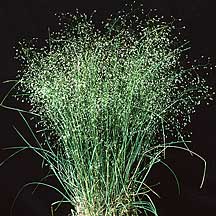Indian ricegrass facts for kids
Quick facts for kids Indian ricegrass |
|
|---|---|
 |
|
| Indian ricegrass growing in cryptobiotic crust at White Sands National Park | |
| Scientific classification | |
| Genus: |
Eriocoma
|
| Species: |
hymenoides
|
| Synonyms | |
|
Synonymy
Oryzopsis hymenoides Ricker ex Piper
Stipa hymenoides Roem. & Schult.(basionym) Eriocoma cuspidata Nutt. Oryzopsis cuspidata (Nutt.) Benth. ex Vasey Achnatherum hymenoides (Roem. & Schult.) Barkworth Eriocoma membranacea (Pursh) Beal 1896 not Steud. 1840 Fendleria rhynchelytroides Steud. Milium cuspidatum (Nutt.) Spreng. Oryzopsis membranacea (Pursh) Vasey Stipa membranacea Pursh Urachne lanata Trin. |
|
Eriocoma hymenoides (common names: Indian ricegrass and sand rice grass) is a cool-season, perennial bunchgrass with narrow, rolled leaf blades. It is native to western North America east of the Cascades from British Columbia and Alberta south to southern California, northeastern Mexico, and Texas.
Contents
Description
In the wild, it typically grows 4 to 24 in (10 to 61 cm) tall and 8 to 12 in (20 to 30 cm) wide.
Habitat
E. hymenoides grows in a variety of habitats from desert scrub to ponderosa pine forests. It can live in soils from sand to clay, but it does particularly well in sand, where it is the dominant grass growing with sagebrush, and may occur almost unmixed with other plants. It stabilizes shifting sand.
Cultivation
Indian ricegrass is an important food for livestock and for wild grazers such as bison, desert bighorn sheep, elk, mule deer, pronghorns, and jackrabbits. For some of these species, it is especially vital in late winter, as it produces green shoots earlier than other grasses. The seeds are heavily consumed by many rodents and birds, notably mourning doves.
This tough grass is known for its ability to reseed and establish itself on sites damaged by fire or overgrazing. Much germination occurs in years with wet Aprils. It is grown in xeriscapes—cultivars are available—and will become quite large if given sufficient space. The open, spangled appearance when in flower or fruit is very attractive, especially in backlight. The flower stalk is commonly used in dry flower arrangements.
Uses
In the past, the grass was a staple food of Native Americans, especially when the maize crop failed, and for non-agricultural tribes. Seed of the ricegrass was gathered and ground into meal or flour and made into bread. Since 2000, the ricegrass has been cultivated in Montana and marketed under the trade name Montina as a gluten-free grain. The Zuni people used the ground seeds as a staple before the availability of corn.
Symbol
It was officially recognized as the Nevada state grass in 1977, and as the Utah state grass in 1990.
The Utah Section of the Society for Range Management began campaigning for a state grass in the mid-1980s, and after studying many species the field was narrowed to four candidates, Indian ricegrass, bluebunch wheatgrass, galleta grass, and Great Basin wildrye. Indian ricegrass was then selected. The state-grass bill was introduced by Senator Alarik Myrin, a member of the Society, in 1989.
See also
 In Spanish: Oryzopsis hymenoides para niños
In Spanish: Oryzopsis hymenoides para niños


